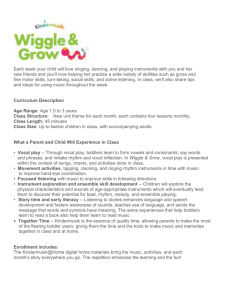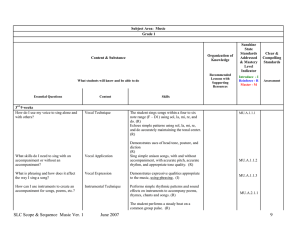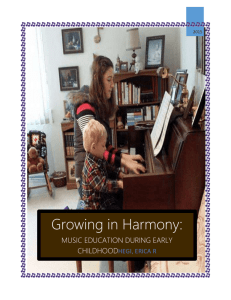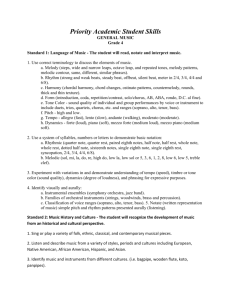K-12 Vocal Music Curriculum - Muscatine Community School District
advertisement
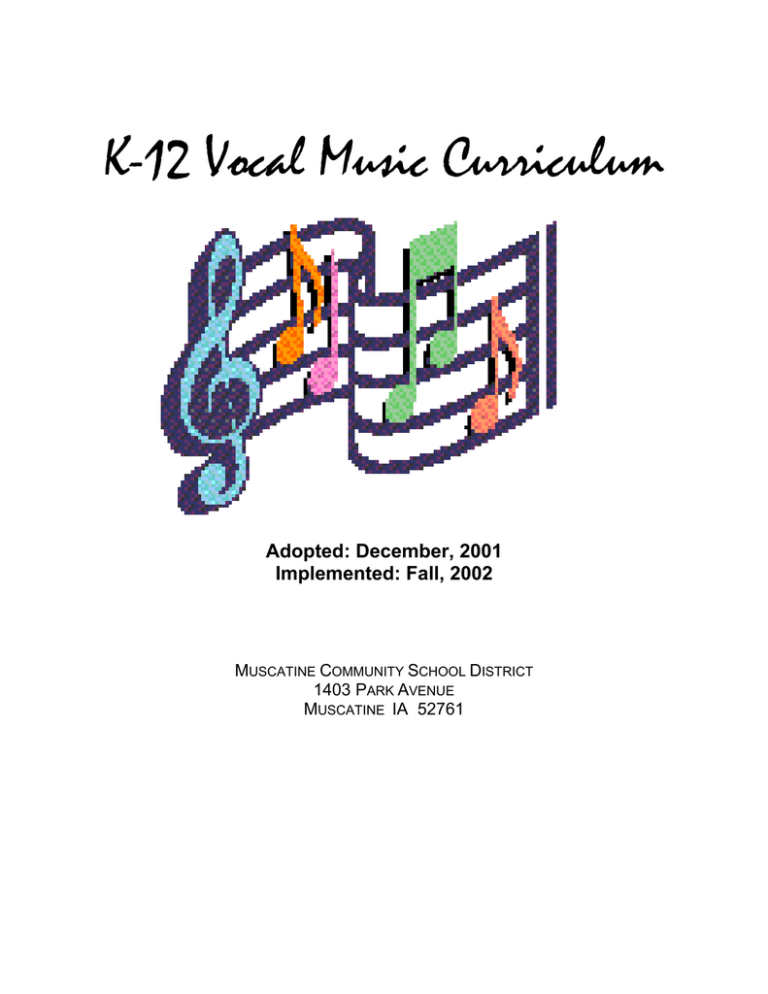
K-12 Vocal Music Curriculum Adopted: December, 2001 Implemented: Fall, 2002 MUSCATINE COMMUNITY SCHOOL DISTRICT 1403 PARK AVENUE MUSCATINE IA 52761 TABLE OF CONTENTS Page K-12 Vocal Music Curriculum Committee ......................................................................................... I Mission, Vision, Philosophy...............................................................................................................ii Explanation of Curriculum Guide ..................................................................................................... iii Standard 1: Singing, alone and with others, a varied repertoire of music. K-5 ....................................................................................................................................... 1 6-8 ....................................................................................................................................... 1 9-12 ..................................................................................................................................... 1 Standard 2: Performing on instruments, alone and with others, a varied repertoire of music. K-5 ....................................................................................................................................... 2 6-8 ....................................................................................................................................... 2 9-12 ..................................................................................................................................... 2 Standard 3: Improvising melodies, variations, and accompaniments. K-5 ....................................................................................................................................... 3 6-8 ....................................................................................................................................... 3 9-12 ..................................................................................................................................... 3 Standard 4: Composing and arranging music within specified guidelines. K-5 ....................................................................................................................................... 4 6-8 ....................................................................................................................................... 4 9-12 ..................................................................................................................................... 4 Standard 5: Reading and notating music. K-5 ....................................................................................................................................... 5 6-8 ....................................................................................................................................... 5 9-12 ..................................................................................................................................... 5 Standard 6: Listening to, analyzing and describing music. K-5 ....................................................................................................................................... 6 6-8 ....................................................................................................................................... 6 9-12 ..................................................................................................................................... 7 Standard 7: Evaluating music and music performances. K-5 ....................................................................................................................................... 7 6-8 ....................................................................................................................................... 8 9-12 ..................................................................................................................................... 8 Standard 8: Understanding relationships between music, the other Arts, and disciplines outside the arts. K-5 ....................................................................................................................................... 8 6-8 ....................................................................................................................................... 9 9-12 ..................................................................................................................................... 9 Standard 9: Understanding music in relation to history and culture. K-5 ..................................................................................................................................... 10 6-8 ..................................................................................................................................... 10 9-12 ................................................................................................................................... 10 Page First Grade Benchmarks Chart ...................................................................................................... 12 Second Grade Benchmarks Chart ................................................................................................. 13 Third Grade Benchmarks Chart ..................................................................................................... 14 Fourth Grade Benchmarks Chart ................................................................................................... 15 Fifth Grade Benchmarks Chart ...................................................................................................... 16 Middle School Chorus .................................................................................................................... 17 High School Chorus ....................................................................................................................... 19 K-12 MUSIC CURRICULUM COMMITTEE ELEMENTARY Sue Robinson Richard Sessler Linda Buchele Cindy Garvin Karen Meyer Carol Ostrem MIDDLE SCHOOL Bob Danner Judy Wilson HIGH SCHOOL Lori Carroll Matthew Armstrong ADMINISTRATORS Shari Antisdel Jane Evans i MISSION The mission of the Muscatine Community School District is to ensure excellence in education for every student. VISION The Muscatine Community School District will provide a safe, nurturing environment where academic excellence is expected and diversity is recognized as a strength. We will meet individual needs while developing independent learners who are also successful team players. We will embrace innovative practices that are research-based and promote high levels of student learning. Technology-rich classrooms will enhance active learning and excitement. Interior and exterior walls will become seamless as learners and the community collaborate. Our students will achieve positive social skills, which promote respect and responsibility to self, family and community, resulting in positive self-esteem. School-community partnerships will prepare and challenge each individual to become a goal-oriented, lifelong learner in an ever-changing global society. K-12 MUSIC PHILOSOPHY Music is a basic part of a quality educational program. Music education builds selfdiscipline; encourages cooperation, poise, and a feeling of self-worth. It provides a framework for personal, creative, expressive, emotional responses, and for simple enjoyment. The aesthetic potential of all students should be fully cultivated and strengthened. Music contributes to a students’ awareness and respect for the global community and the spirit of many different peoples. Music inspires humanity with hope, kindles love, gives a voice to the feeling of cheer and soothes in times of despair. ii EXPLANATION TO VOCAL MUSIC CURRICULUM GUIDE The study of music contributes in important ways to the quality of every student’s life. Every musical work is a product of its time and place, although some works transcend their original settings and continue to appeal to humans through their timeless and universal attraction. Through singing, playing instruments, and composing, students can express themselves creatively, while a knowledge of notation and performance traditions enables them to learn new music independently throughout their lives. Skills in analysis, evaluation, and synthesis are important because they enable students to recognize and pursue excellence in their musical experiences and to understand and enrich their environment. Because music is an integral part of human history, the ability to listen with understanding is essential if students are to gain a broad cultural and historical perspective. The adult life of every student is enriched by the skills, knowledge, and habits acquired in the study of music. GRADES 9-12 Two levels of achievement, “proficient” and “advanced,” have been established for grades 9-12. The proficient level is intended for students who have completed courses involving relevant skills and knowledge for one to two years beyond grade 8. The advanced level is intended for students who have completed courses involving relevant skills and knowledge for three to four years beyond grade 8. Students at the advanced level are expected to achieve the standards established for the proficient as well as the advanced levels. Every student is expected to achieve the proficient level in at least one arts discipline (that is, music, dance, theatre, visual arts) by the time he or she graduates from high school. The standards in the high school section describe the cumulative skills and knowledge expected of students exiting grade 12 who have enrolled in relevant music courses. They presume that the students have achieved the standards specified for grade 5-8; they assume that the students will demonstrate higher levels of the expected skills and knowledge, will deal with increasingly complex music, and will provide more sophisticated responses to works of music. Every course in music, including performance courses, should provide instruction in creating, performing, listening to, and analyzing music, in addition to focusing on its specific subject matter. iii MUSCATINE COMMUNITY SCHOOL DISTRICT Vocal Music Standards and Benchmarks STANDARD 1 Singing, alone and with others, a varied repertoire of music. Level K-5 Therefore, the student will: 1. Sing independently, on pitch and in rhythm, with appropriate timbre, diction, and posture, and maintain a steady tempo. 2. Sing expressively, with appropriate dynamics, phrasing, and interpretation. 3. Sing from memory a varied repertoire of songs representing genres and styles from diverse cultures. 4. Sing ostinatos, rounds & partner songs. 5. Sing in groups, blending vocal timbres, matching dynamic levels, and responding to the cues of a conductor. Level 6-8 Therefore, the student will: 1. 2. 3. Sing on pitch with correct rhythm, maintaining a steady tempo. Students will be aware of proper posture, breathing and diction techniques. Demonstrate capability to sing limited harmony parts, rounds and/or partner songs. Demonstrate knowledge of various dynamic levels. Level 9-12 Therefore, the student will: ACHIEVEMENT STANDARD, PROFICIENT: 1. 2. 3. Sing with expression and technical accuracy a large and varied repertoire of vocal literature with a level of difficulty of 4, on a scale of 1 to 6, including some songs performed from memory. Sing music written in four parts, with and without accompaniment. Demonstrate well-developed ensemble skills. 1 ACHIEVEMENT STANDARD, ADVANCED: 4. 5. 6. Sing with expression and technical accuracy a large and varied repertoire of instrumental literature with a level of difficulty of 4, on a scale of 1 to 6. Sing music written in more than four parts. Sing in small ensembles with one student on a part. STANDARD 2 Performing on instruments, alone and with others, a varied repertoire of music. Level K-5 Therefore, the student will: 1. 2. 3. Perform on classroom instruments rhythm, melodic and harmonic patterns. Echo patterns with correct rhythm and tempo. Perform independent instrumental parts while other students sing or play contrasting parts. Level 6-8 Therefore, the student will: 1. 2. 3. 4. Demonstrate ability to perform on classroom rhythmic and melodic instruments a variety of rhythmic and melodic patterns. Demonstrate rhythmic and melodic memory. Demonstrate ability to perform rhythm patterns on percussion instruments, while singing. Demonstrate ability to play melody and chord patterns on bells or keyboards. Level 9-12 Therefore, the student will: ACHIEVEMENT STANDARD, PROFICIENT: 1. 2. 3. Perform with expression and technical accuracy a large and varied repertoire of instrumental literature with a level of difficulty of 4, on a scale of 1 to 6. Perform an appropriate part in an ensemble, demonstrating well-developed ensemble skills. Perform in small ensembles with one student on a part. 2 ACHIEVEMENT STANDARD, ADVANCED: 4. Perform with expression and technical accuracy a large and varied repertoire of instrumental literature with a level of difficulty of 5, on a scale of 1 to 6. STANDARD 3 Improvising melodies, variations, and accompaniments. Level K-5 Therefore, the student will: 1. 2. 3. 4. Improvise “answers” in the same style to rhythmic and melodic phrases. Improvise simple melodic embellishments. Improvise story characters. Improvise appropriate movement to different musical styles. Level 6-8 Therefore, the student will: 1. Demonstrate ability to improvise rhythmic/melodic patterns in appropriate styles of music studied. Level 9-12 Therefore, the student will: ACHIEVEMENT STANDARD, PROFICIENT: 1. 2. 3. Improvise stylistically appropriate harmonizing parts. Improvise rhythmic and melodic variations on given pentatonic melodies and melodies in major and minor keys. Improvise original melodies over given chord progressions, each in a consistent style, meter, and tonality. ACHIEVEMENT STANDARD, ADVANCED: 4. 5. Improvise stylistically appropriate harmonizing parts in a variety of styles. Improvise original melodies in a variety of styles, over given chord progressions, each in a consistent style, meter, and tonality. 3 STANDARD 4 Composing and arranging music within specified guidelines. Level K-5 Therefore, the student will: 1. 2. Participate in creating group compositions. Use a variety of sound sources when composing. Level 6-8 Therefore, the student will: 1. Participate in creating group compositions which include lyrics, melody, rhythm and harmony. Level 9-12 Therefore, the student will: Achievement Standard, Proficient: 1. 2. 3. Compose music in several distinct styles, demonstrating creativity in using the elements of music for expressive effect. Arrange pieces for voices or instruments other than those for which the pieces were written in ways that preserve or enhance the expressive effect of the music. Compose and arrange music for voices and various acoustic and electronic instruments, demonstrating knowledge of the ranges and traditional usages of the sound sources. Achievement Standard, Advanced: 4. Compose music, demonstrating imagination and technical skill in applying the principles of composition. 4 STANDARD 5 Reading and notating music. Level K-5 Therefore, the student will: 1. 2. 3. Read whole, half, dotted half, quarter, and eighth notes and rests in 2/4, 3/4, and 4/4 meter signatures. Use a system (that is, syllables, numbers, or letters) to read simple pitch notation in the treble clef in major keys. Identify symbols and traditional terms referring to dynamics, tempo, and articulation and interpret them correctly when performing. Level 6-8 Therefore, the student will: 1. 2. 3. Recognize and use the following note/rest values: whole, half, dotted half, quarter, and eighth in 2/4, 3/4 and 4/4 meter signatures. Identify pitches on the staff in the treble clef and bass clef and be able to perform simple melodies on keyboards or bells. Identify and understand the meaning of basic dynamic and tempo markings and other musical symbols. Level 9-12 Therefore, the student will: Achievement Standard, Proficient: 1. Demonstrate the ability to read an instrumental or vocal score of up to four staves by describing how the elements of music are used. Students who participate in a choral or instrumental ensemble or class will: 2. Sightread, accurately and expressively, music with a level of difficulty of 3, on a scale of 1 to 6. Achievement Standard, Advanced: 3. Demonstrate the ability to read a full instrumental or vocal score by describing how the elements of music are used and explaining all transpositions and clefs. 5 4. Interpret nonstandard notation symbols used by some 20th-century composers. Students who participate in a choral or instrumental ensemble or class will: 5. Sightread, accurately and expressively, music with a level of difficulty of 4, on a scale of 1 to 6. STANDARD 6 Listening to, analyzing, and describing music. Level K-5 Therefore, the student will: 1. 2. 3. 4. 5. Identify simple music forms when presented aurally. Demonstrate perceptual skills by moving, by answering questions about, and by describing aural examples of music. Use appropriate terminology in explaining music, music notation, music instruments and voices, and music performances. Identify the sounds of a variety of instruments, including many orchestra and band instruments, and instruments from various cultures, as well as children’s voices and male and female adult voices. Respond through purposeful movement (swaying, skipping, dramatic play) to selected prominent music characteristics. Level 6-8 Therefore, the student will: 1. 2. 3. 4. 5. Identify AB, ABA, and Theme and Variations forms. Identify various styles of musical examples listened to (patriotic, jazz, classical, rock, country, folk, ethnic, etc.). Identify and classify orchestral, folk and band instruments both visually and aurally. Identify and classify children and adult voices (soprano, alto, tenor, bass). Improvise stylistically appropriate accompaniments on rhythm instruments. 6 Level 9-12 Therefore, the student will: Achievement Standard, Proficient: 1. 2. 3. Analyze aural examples of a varied repertoire of music, representing diverse genres and cultures, by describing the uses of elements of music and expressive devices (e.g., rubato, dynamics). Demonstrate extensive knowledge of the technical vocabulary of music. Identify and explain compositional devices and techniques used to provide unity and variety; and tension and release in a musical work and give examples of other works that make similar uses of these devices and techniques. Achievement Standard, Advanced: 4. 5. 6. Demonstrate the ability to perceive and remember music events by describing in detail significant events (e.g., fugal entrances, chromatic modulations, developmental devices) occurring in a given aural example. Compare ways in which musical materials are used in a given example relative to ways in which they are used in other works of the same genre or style. Analyze and describe uses of the elements of music in a given work that make it unique, interesting, and expressive. STANDARD 7 Evaluating music and music performances. Level K-5 Therefore, the student will: 1. 2. Evaluate performances and compositions through discussion and written comments. Evaluate music examples of specific musical works and styles. 7 Level 6-8 Therefore, the student will: 1. 2. Compare and contrast two different performances of the same work through discussion and written comments. Form a personal opinion about musical examples and be able to back up their opinion. Level 9-12 Therefore, the student will: Achievement Standard, Proficient: 1. 2. Evolve specific criteria for making informed, critical evaluations of the quality and effectiveness of performances, compositions, arrangements, and improvisations and apply the criteria in their personal participation in music. Evaluate a performance, composition, arrangement, or improvisation by comparing it to similar or exemplary models. Achievement Standard, Advanced: 3. Evaluate a given musical work in terms of its aesthetic qualities and explain the musical means it uses to evoke feelings and emotions. STANDARD 8 Understanding relationships between music, the other arts, and disciplines outside the arts. Level K-5 Therefore, the student will: 1. 2. Identify similarities and differences in the meanings of common terms (form, line, contrast) used in the various arts. Identify ways in which the principles and subject matter of other disciplines taught in the school are interrelated with those of music. (Math-values of notes; Science-vibration of strings; and Geography-ethnic music from various countries). 8 Level 6-8 Therefore, the student will: 1. 2. 3. Identify common terms used in various arts i.e. form, line, repetition, contrast, tone color, rhythm. Understand the mathematical relationships of note and rest values. Understand the use of phrasing, form and composition in reading and relating them to music. Level 9-12 Therefore, the student will: Achievement Standard, Proficient: 1. 2. 3. Explain how elements, artistic process (e.g., imagination, craftsmanship), and organizational principles (e.g., unity and variety, repetition and contrast) are used in similar and distinctive ways in the various arts and cite examples. Compare characteristics of two or more arts within a particular historical period or style and cite examples from various cultures (e.g., Baroque, sub-Saharan African, Korean). Explain ways in which the principles and subject matter of various disciplines outside the arts are interrelated with those of music (e.g., language arts: compare the ability of music and literature to convey images, feelings, and meanings; physics: describe the physical basis of tone production in string, wind, percussion, electronic instruments, the human voice, and of the transmission and perception of sound). Achievement Standard, Advanced: 4. 5. Compare the uses of characteristic elements, artistic processes, and organizational principles among the arts in different historical periods and different cultures. Explain how the roles of creators, performers, and others involved in the production and presentation of the arts are similar to and different from one another in the various arts (e.g., creators: painters, composers, choreographers, playwrights; performers: instrumentalists, singers, dancers, actors; others: conductors, costumers, directors, lighting designers). 9 STANDARD 9 Understanding music in relation to history and culture. Level K-5 Therefore, the student will: 1. 2. 3. 4. Identify by genre or style aural examples of music from various historical periods and cultures. Identify various uses of music in their daily experiences and describe characteristics that make certain music suitable for each use. Identify and describe roles of musicians in various music settings and cultures. Demonstrate audience behavior appropriate for the context and style of music performed. Level 6-8 Therefore, the student will: 1. 2. 3. 4. Be aware of the relationship of different musical styles to the historical period in which they were produced (baroque, classical, romantic, 20th century, jazz, rock, patriotic). Be aware of the appropriate use of music to accompany and enhance various activities (sporting events, family events, holidays, religious events). Be aware of the role of music in society. Understand the appropriate concert etiquette both on stage and off. Level 9-12 Therefore, the student will: Achievement Standard, Proficient: 1. 2. 3. Classify by genre or style and by historical period or culture unfamiliar but representative aural examples of music and explain the reasoning behind their classifications. Identify sources of American music genres (e.g., swing, Broadway musical, blues), trace the evolution of those genres, and cite well-known musicians associated with them. Identify various roles (e.g., entertainer, teacher, transmitter of cultural tradition) that musicians perform, cite representative individuals who have functioned in each role, and describe their activities and achievements. 10 Achievement Standard, Advanced: 4. 5. Identify and explain the stylistic features of a given musical work that serve to define its aesthetic tradition and its historical or cultural context. Identify and describe music genres or styles that show the influence of two or more cultural traditions, identify the cultural source of each influence, and trace the historical conditions that produced the synthesis of influences. 11 First Grade Melody Rhythm Expressive Qualities Sing songs using ostinatos & rounds Sing songs across curriculum Vocal ProductionPosture, Clear Diction & Dynamics Perform with Echo rhythm Fast & Slow steady beat. patterns. Tempos Duple & Triple Meter Quarter & eighth note notation Matches pitch (s-m) Loud & soft songs Melody direction (high-low, steps, skips & repeats) Discuss feelings-mood Lullabies & marches Creative movement (tempo) Rounds Harmony Texture (thick Harmony or or thin) no harmony Ostinatos Form Repetition & A, AB, ABA, Contrast Call & response Tone Color Whisper, Differentiate speak, call & children & adult voices sing Identify classroom instruments Special Units Song stories Dramatize Seasonal music High & low sounds Beat & rhythm Body percussion Co-curricular Game songs Composers music 12 Chanting Etiquette for listening & performing Second Grade Melody Matches pitches in extended range. Rhythm Instrumental ostinatos Harmony Chords with various instruments Melodic direction & contour Identify & produce even & uneven rhythm patterns Expressive Identify forte & Crescendo & Qualities piano symbols decrescendo Form Move to show Introductions sections of & codas music Tone Color Experiment with timbre Special Units Keyboards Pitched & unpitched instruments Ostinatos, Rounds & Partner Songs Sing songs across the curriculum Accents Identify quarter,eighth half notes & rests Listening Maps Verse & refrain Improvise interludes Repeat signs Appropriate Differentiate choice of individual vocal timbre timbres Instrument families Ethnic instruments & styles Seasonal music Co-curricular Composers music Ethnic music Folk dances & Instruments 13 Game songs Breath support thru phrases Third Grade Melody Learn pentatonic syllables Rhythm Improvise rhythm patterns Scales & octaves Major & minor tonalities Sing songs Vocal Melodic across the production/ patterns curriculum posture & clear diction x x x x Fermatas Sixteenth & Whole notes& rests Expressive Staccato & Phrasing Articulation Qualities legato Harmony Recognize major & minor Form Theme & Variations Rondo Form Tone Color Identify instruments within families Create Special Units Game songs Cocurricular units Identify interludes Seasonal music Orff Keyboards instruments 14 Ethnic Technology Musicals music & instruments Fourth Grade Melody Sing with Respond to Improvise correct conductor patterns articulation. cues Rhythm Tempo Conductor Numerical terminology beat counting patterns Memorize letter names of treble clef Sharps, flats & naturals x x x x Expressive mp, mf, ff, Ritardando Qualities pp & Accelerand o Harmony Chord roots Form Phrase form Tone Color Vocal registers Special Units Recorders Counter melodies D.C. al Fine, D.S. al Fine, Fine & Codas SATB Ukeleles Partner songs Band or Solo, duet, orchestra trio & quartets Seasonal Keyboards Orff Technology Evaluate Ethnic Musicals music & coinstruments performusic & curricular mances instruments music 15 Fifth Grade Whole & half steps (Scales) Two-part harmony Key Sing songs Vocal Accidentals signatures across the production/ curriculum posture & clear diction x x x x x Musicals Ukeleles Music historical periods Syncopatio n Sensitivity Critical thinking Higher order thinking Chord Instrumenta cadences l chords &progressio ns Review all forms Introduce Combine & Compose conductor blend with various scores timbres timbres CoOrff Ethnic curricular & instruments music & seasonal instruments music Evaluate Technology Keyboards performances 16 MIDDLE SCHOOL CHORUS Not all standards that can be applied to general music can also be applied to the vocal music curriculum. Standard 1: Sings, alone and with others, a varied repertoire of music. • Sings with good breath control, expression and technical accuracy at a level that includes appropriate ranges and changes of tempo, key, and meter. •Grade 6: sings music in unison, two and three part harmony. •Grade 7: sings music in unison, two and three part treble and bass clef harmony. •Grade 8: sings music in unison, two and three part treble and two part bass clef harmony. • Sings and performs music that represents diverse genres and cultures (vocal jazz, musical theater, swing, classical, pop, spiritual, sacred, patriotic, and multi-cultural). Standard 2: Reads music • Can recognize and perform whole, half, quarter, eighth, sixteenth and dotted notes in a variety of meter signatures. • Reads at sight simple melodies, rhythms and harmonies in the appropriate range. • Knows standard notation symbols for pitch, rhythm, dynamics, tempo, articulation and expression. Standard 3: Knows and applies appropriate criteria to music and music performances • Demonstrates appropriate concert etiquette for both the performer and the listener. • Understands the technical vocabulary of music. • Understands that the style of music being performed requires changes in the type of vocal production. Standard 4: Understands the relationship between music history and culture. • Understands the characteristics of music from various historical periods and cultures. 17 • Understands the relationship of musical style to the historical events of the period in which it was produced. • Understands the relationship of musical style to a given culture. Standard 5: Understands the relationship between music and emotion. • Is able to perform music that expresses a variety of emotions (joy, sorrow, excitement, reverence, anger, etc.). 18 HIGH SCHOOL CHORUS The High School Chorus should build upon the seventh- and eighth-grade vocal training, and continue as follows: I. The program will provide students the opportunity to learn about pitch. The student will: II. A. Sing a melody that is written in musical notation and develop an awareness of melodic patterns, tonal and chordal. B. Recognize and sing all major and minor intervals. C. Sing major and minor scales, one octave beginning on any step of the scale. D. Sing two-, three-, and four-part harmony with mixed chorus. E. Learn to maintain pitch singing acappella or with accompaniment. F. Perform vocalises that stress: 1. Head voice 2. Chest voice 3. Falsetto 4. Breath support 5. Blend 6. Balance The program will provide students the opportunity to learn about performance. The student will: III. A. Develop his/her musicianship and performance skill to the fullest potential. B. Develop an appreciation and enjoyment of music as a vehicle for recreation, pleasure and performance. C. Develop poise, self-discipline, responsibility and cooperation through his/her performance. The program will provide students the opportunity to learn about literature. 19 The student will: IV. A. Perform literature selected on a seasonal basis. B. Perform acappella and accompanied music. C. Perform sacred, secular, folk, popular and contemporary literature. The program will provide students the opportunity to learn about tone color. The student will: A. Use consistently proper singing techniques to produce a characteristic tone color. 1. Breath support 2. Posture 3. Vowel formation and placement 4. Attack and release B. Demonstrate an understanding of the difference between head voice, chest voice and falsetto. C. Demonstrate an understanding of the transition between vocal registers, over the break into falsetto (head voice). D. Adjust vocal tone quality and vowel color to achieve ensemble balance and blend. 20


